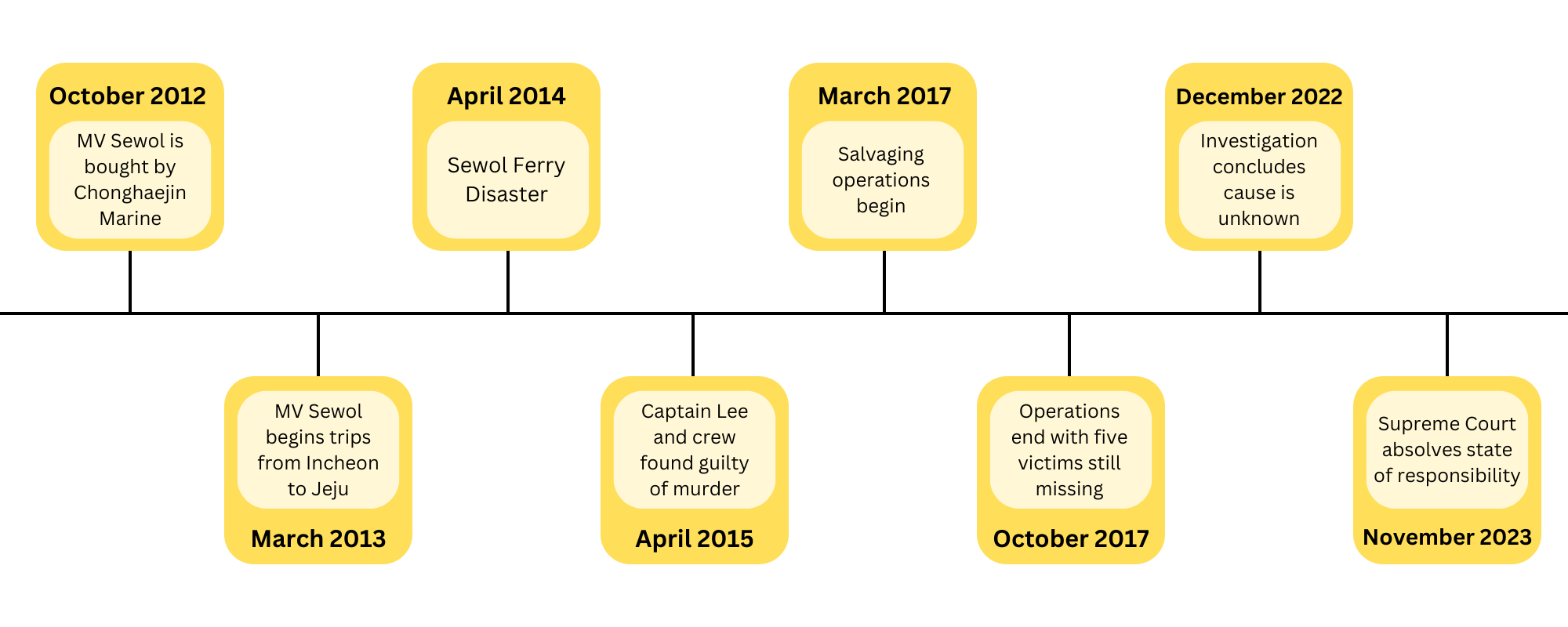Seven Standen
On 16th April 2014, the MV Sewol ferry sank en route from Incheon, South Korea, towards Jeju Island, resulting in the deaths of 306 passengers and crew members. Of those who died, 250 were students from Danwon High School.
The incident caused outrage in South Korea, due to the failures of both the ferry staff and Korea Coast Guard (KCG). The government was highly criticised for their attempts to downplay the Sewol Ferry Tragedy.
A little under a month later, the captain and three crew members were charged with murder. The other eleven members of the crew were indicted for abandoning the ship. An arrest warrant was issued for Yoo Byung-eun, the owner of Chonghaejin Marine Company Ltd, who operated the MV Sewol ferry. Before he could be arrested, Yoo was found dead of unknown causes. But the public, especially the families of Danwon students, felt the officials’ response to the disaster wasn’t good enough.
Now, exactly a decade has passed since the Sewol Ferry Disaster took place. What has changed in South Korea? Do the survivors and families of victims feel differently than they did ten years ago? Why has the tragedy been overshadowed by similar events, such as Oceangate, rather than becoming a cautionary tale?
The Sinking Of The MV Sewol Ferry
Ten years later, the real story behind the sinking is still disputed.
While the Maenggol Channel has strong currents, hazardous rock, and shallow waters, the boat was following a frequently used route on 16th April. Third mate Park Han-kyul and helmsman Cho Joon-ki, who were steering the ferry, took several turns to the right. Due to the turns, the ship started listing severely to one side. Although the details of Park and Cho’s turns are unclear, attempts to stabilise the ship ultimately failed.
Investigations found that overloading was the main reason behind the MV Sewol sinking. The sudden turn caused all the cargo to move to one side of the ship, resulting in a loud ‘bang’, and made it impossible to restore balance. After the engines were shut off, the boat drifted listlessly and was unable to change directions.
“More than half of survivors were rescued by fishing boats […] rather than the coast guard.”
Passengers were ordered to stay put, even as Captain Lee Joon-seok and his crew abandoned the ship.
From the boat’s initial right turn at 8:48am, it took two and a half hours for it to be completely submerged. But there was no communication from passengers after 10:17am. Only 172 of the 476 those onboard survived. More than half of survivors were rescued by fishing boats and other commercial vessels, rather than the coast guard.
The Sewol Ferry Tragedy has been declared one of the worst maritime disasters in South Korean history.
The Tragedy Of The Sewol Ferry
What made the Sewol Ferry so shocking wasn’t just the amount of preventable deaths, but the fact that 250 of those deaths were high school students. The students from Danwon High School were on a field trip to Jeju Island, which is an idyllic holiday destination for South Koreans.
In South Korea, children are raised in a ‘culture of obedience’ and expected to follow orders from authority figures. The majority of students onboard the ferry obeyed instructions issued over the intercom: “Do not move. Just stay where you are. It’s dangerous if you move, so just stay where you are.”
Jang Ae-jin, who was among the few students who survived, said: “We have always been told that we’d be safe if we follow instructions [so] we followed the instructions.”
While the vessel listed violently to one side and water began to flood the MV Sewol, most students put on life jackets and stayed in their cabins. Jang recalled standing on her luggage to avoid the water.
Because the tragedy took place in 2014, there are a wealth of videos and messages recorded by the victims. Several videos start out with teenagers joking about the ship tilting and feeling seasick, before devolving into confusion and fear. Many expressed love for their family or classmates after realising they wouldn’t survive. One student assured their classmates that all of them would live and remarked they would see each other later.

How South Korea Was Impacted
Investigations by the Social Disasters Commission (SDC) were unable to determine an official cause for the ferry sinking. But this has been criticised, including by the families of victims: they argued the failed rescue attempts and shady political behaviour were not investigated thoroughly. In addition to the disaster being handled badly by officials, it wouldn’t have happened in the first place if the boat had undergone proper regulation checks and emergency officials responded faster. This resulted in nationwide outrage and widespread distrust of officials.
The sinking of the Sewol Ferry resulted in a political overhaul. President Park Geun-hye’s poor handling of the disaster resulted in her political downfall and she was impeached in March 2017. Later, in July, several members of Park’s administration were imprisoned for trying to silence artists commemorating Sewol’s victims.
“Yellow ribbons — initially used a symbol of mourning — are now tied closely to political activism in South Korea.”
Like many tragic events, the story of the Sewol Ferry Disaster has been immortalised in South Korean pop culture. Birthday (2019) was the first movie about the incident and explores how families of the deceased were affected in the aftermath. Music videos for ‘One Of These Nights’ (2016) by Red Velvet and ‘Spring Day’ (2017) by BTS are both speculated to pay homage to the tragedy. Korean viewers even suggested that the recent Netflix series All Of Us Are Dead (2022) was an allegory for the Sewol Disaster.
Most interestingly, yellow ribbons — initially a symbol of mourning — are now tied closely to political activism in South Korea. The tragedy represents the failures of official Korean organisations, including the coast guard and government, to protect the lives of the public sufficiently. Ten years later, the state hasn’t taken any responsibility for the disaster. Due to the political connotations, yellow ribbons have been banned in Korean schools.
What Makes A Tragedy Universal?
In South Korea, the MV Sewol was a devastating tragedy that shook the nation. But ten years later, the Sewol Ferry Tragedy remains relatively unknown elsewhere. Why has this disaster faded into obscurity, when it was worldwide news at the time?
For over 100 years, the sinking of the RMS Titanic has fascinated the world. It is cemented in popular culture as a symbol of technological hubris, a metaphor for divisions of class and race, and a story of tragic disaster. Despite being a real event, the 1912 tragedy has become more of a modern myth. It’s comparable to those from Ancient Greece. The story of the Titanic is generally accepted as a universal tragedy.
The Sewol Ferry Incident shares many similarities with the sinking of the Titanic, including the poor decisions of the captain and crew, inadequate safety measures and the passenger deaths. Even onboard the Titanic, people calmly obeyed instructions and didn’t panic in the face of the iceberg. Although, James Cameron’s 1997 adaptation has rewritten this narrative.
Whether it was due to the MV Sewol’s less glamorous status, having fewer passengers or taking place in Asia, the Sewol Ferry Tragedy isn’t a ‘universal tragedy’. In the West, people are more likely to know about the OceanGate submersible implosion. But the ferry will remain an iconic symbol, much like the Titanic, in South Korea.
Read Next:
-
WHAT DOES WOMEN’S HISTORY MONTH MEAN IN 2024?
-
THE BOOM IN CELEBRITY RESTAURANTS: ARE THEY DAMAGING LOCAL BUSINESSES?
-
THE IMPACT OF TOURING ON ARTISTS
Featured image courtesy of Republic of Korea on Flickr. No changes made to this image. Image license here.

